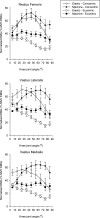Muscle activity during knee-extension strengthening exercise performed with elastic tubing and isotonic resistance
- PMID: 23316424
- PMCID: PMC3537465
Muscle activity during knee-extension strengthening exercise performed with elastic tubing and isotonic resistance
Abstract
Background/purpose: While elastic resistance training, targeting the upper body is effective for strength training, the effect of elastic resistance training on lower body muscle activity remains questionable. The purpose of this study was to evaluate the EMG-angle relationship of the quadriceps muscle during 10-RM knee-extensions performed with elastic tubing and an isotonic strength training machine.
Methods: 7 women and 9 men aged 28-67 years (mean age 44 and 41 years, respectively) participated. Electromyographic (EMG) activity was recorded in 10 muscles during the concentric and eccentric contraction phase of a knee extension exercise performed with elastic tubing and in training machine and normalized to maximal voluntary isometric contraction (MVC) EMG (nEMG). Knee joint angle was measured during the exercises using electronic inclinometers (range of motion 0-90°).
Results: When comparing the machine and elastic resistance exercises there were no significant differences in peak EMG of the rectus femoris (RF), vastus lateralis (VL), vastus medialis (VM) during the concentric contraction phase. However, during the eccentric phase, peak EMG was significantly higher (p<0.01) in RF and VM when performing knee extensions using the training machine. In VL and VM the EMG-angle pattern was different between the two training modalities (significant angle by exercise interaction). When using elastic resistance, the EMG-angle pattern peaked towards full knee extension (0°), whereas angle at peak EMG occurred closer to knee flexion position (90°) during the machine exercise. Perceived loading (Borg CR10) was similar during knee extensions performed with elastic tubing (5.7±0.6) compared with knee extensions performed in training machine (5.9±0.5).
Conclusion: Knee extensions performed with elastic tubing induces similar high (>70% nEMG) quadriceps muscle activity during the concentric contraction phase, but slightly lower during the eccentric contraction phase, as knee extensions performed using an isotonic training machine. During the concentric contraction phase the two different conditions displayed reciprocal EMG-angle patterns during the range of motion.
Level of evidence: 5.
Keywords: Electromyography; perceived exertion; quadriceps; strength training.
Figures


Similar articles
-
Effectiveness of hamstring knee rehabilitation exercise performed in training machine vs. elastic resistance: electromyography evaluation study.Am J Phys Med Rehabil. 2014 Apr;93(4):320-7. doi: 10.1097/PHM.0000000000000043. Am J Phys Med Rehabil. 2014. PMID: 24398577 Clinical Trial.
-
Quadriceps femoris electromyogram during concentric, isometric and eccentric phases of fatiguing dynamic knee extensions.J Biomech. 2006;39(2):246-54. doi: 10.1016/j.jbiomech.2004.11.023. J Biomech. 2006. PMID: 16321626 Clinical Trial.
-
Electromyographic Comparison of Elastic Resistance and Machine Exercises for High-Intensity Strength Training in Patients With Chronic Stroke.Arch Phys Med Rehabil. 2016 Mar;97(3):429-36. doi: 10.1016/j.apmr.2015.10.099. Epub 2015 Nov 10. Arch Phys Med Rehabil. 2016. PMID: 26558843
-
Electromyographic activity and applied load during seated quadriceps exercises.Med Sci Sports Exerc. 2001 Oct;33(10):1713-25. doi: 10.1097/00005768-200110000-00016. Med Sci Sports Exerc. 2001. PMID: 11581557
-
Perceived loading and muscle activity during hip strengthening exercises: comparison of elastic resistance and machine exercises.Int J Sports Phys Ther. 2013 Dec;8(6):811-9. Int J Sports Phys Ther. 2013. PMID: 24377067 Free PMC article.
Cited by
-
Focusing on Increasing Velocity during Heavy Resistance Knee Flexion Exercise Boosts Hamstring Muscle Activity in Chronic Stroke Patients.Neurol Res Int. 2016;2016:6523724. doi: 10.1155/2016/6523724. Epub 2016 Jul 25. Neurol Res Int. 2016. PMID: 27525118 Free PMC article.
-
Effects of Chair-Based, Low-Load Elastic Band Resistance Training on Functional Fitness and Metabolic Biomarkers in Older Women.J Sports Sci Med. 2021 Mar 1;20(1):133-141. doi: 10.52082/jssm.2021.133. eCollection 2021 Mar. J Sports Sci Med. 2021. PMID: 33707996 Free PMC article. Clinical Trial.
-
Influence of Fish Oil-Derived n-3 Fatty Acid Supplementation on Changes in Body Composition and Muscle Strength During Short-Term Weight Loss in Resistance-Trained Men.Front Nutr. 2019 Jul 16;6:102. doi: 10.3389/fnut.2019.00102. eCollection 2019. Front Nutr. 2019. PMID: 31380384 Free PMC article.
-
Long-term training on sand changes lower limb muscle activities during running in runners with over-pronated feet.Biomed Eng Online. 2021 Nov 27;20(1):118. doi: 10.1186/s12938-021-00955-8. Biomed Eng Online. 2021. PMID: 34838002 Free PMC article.
-
Strength Training Improves Fatigue Resistance and Self-Rated Health in Workers with Chronic Pain: A Randomized Controlled Trial.Biomed Res Int. 2016;2016:4137918. doi: 10.1155/2016/4137918. Epub 2016 Oct 17. Biomed Res Int. 2016. PMID: 27830144 Free PMC article. Clinical Trial.
References
-
- Kaya D, Citaker S, Kerimoglu U, et al. Women with patellofemoral pain syndrome have quadriceps femoris volume and strength deficiency. Knee Surg Sports Traumatol Arthrosc. 2011;19(2):242–247 - PubMed
-
- Holm B, Kristensen MT, Bencke J, Husted H, Kehlet H, Bandholm T. Loss of knee‐extension strength is related to knee swelling after total knee arthroplasty. Arch Phys Med Rehabil. 2010;91(11):1770–1776 - PubMed
-
- Mizner RL. Emerging perspectives related to quadriceps central activation deficits in patients with total knee arthroplasty. Exerc Sport Sci Rev. 2012;40(2):61–62 - PubMed
-
- Baugher WH, Warren RF, Marshall JL, Joseph A. Quadriceps atrophy in the anterior cruciate insufficient knee. Am J Sports Med. 1984;12(3):192–195 - PubMed
LinkOut - more resources
Full Text Sources
Research Materials
